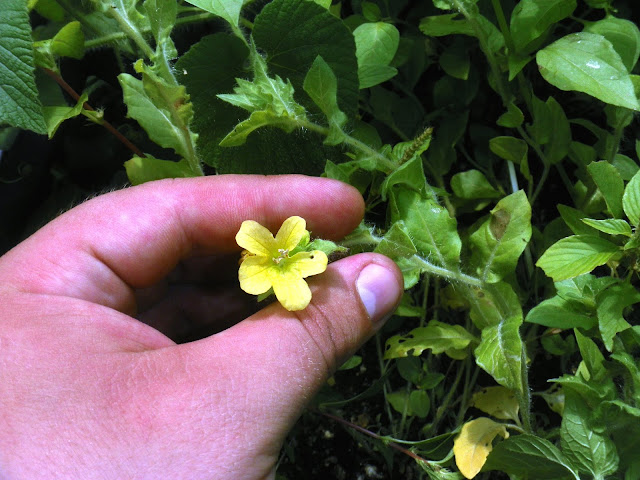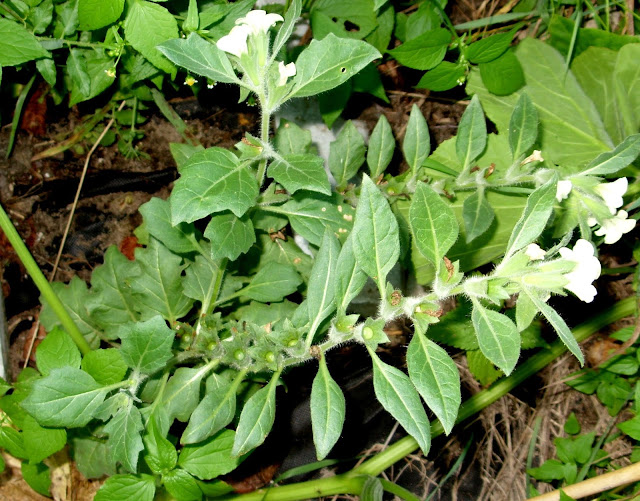There exists about 20 species of nightshades/eggplants (Solanum)
- eggplant (S. melogena) cousins, which belong to section Acanthophora (within subgenus Leptostemonum).
 |
| The immature fruits of Yoa (Solanum palinacanthum) ex Bolivia |
They all are very spiny perennial or
long-living annual herbs. They are mostly origin to South America, but some
species grow also in Africa or southern Asia. They are often very ornamental
and were used also as medicinal, or sometimes even as edible. Some species are weedy. The seeds are
lentil-like shaped and sometimes (in the case of some species) winged. Flowers
are often andromonoecy (there are two kinds of flowers - hermaphroditic and
functionally staminate in the same inflorescence). The fruits (fleshy berries)
are often quite large or medium size and in various colors (yellow, red,
orange, grenish etc. and often green/dark green motted when unripe – so they
looks like small watermelons and are very lovely). I tried to grow 5 species:
Tropical Soda Apple,
Juá-bravo (Solanum viarum) it is very
ornamental shruby perennial native to Brazil and Argentina, to 1-2 m (3-7 ft)
tall and wide, with very prickly stems and leaves, small white flowers and
yellow fruits (green mini watermelon-like when immature). It creates
underground rhizome suckers, and is frost hardy to zones 8b and warmer. In
temperate areas (zone 5-7) can be grown as annual (in the same way as common
tomato - but fruits are inedible). This plant is prohibited in numerous
countries (mainly tropical and subtropical where can be a noxious weed). Can be
slowly to germination - scarification or GA3 may improve germination. Seeds of
this species are hard to find in trading.
 |
| The flowers |
 |
| This plant creates large round bushes of annual stems (and perennial rhizomes) |
 |
| Immature fruits |
 |
| Ripening fruits |
 |
| Ripe fruits |
 |
| The seeds |
Cockroach Berry (Solanum capsicoides, syn. S. ciliatum) it is annual or short-living tropical perennial native to Brazil. It
creates very ornamental red fruits and is used in dry boqueets. The thin white
flesh of these fruits is eaten by children in Brazil. This species is used in southern Australia to
grafting eggplants (Solanum melongena) to obtaining perennial “tree
eggplants” which creates very numerous fruits (much more than not grafted
plants). Seeds of this species are winged (the same as seeds of next species).
 |
| The plant in flowers |
 |
| The immature (ripening) fruit |
 |
| The ripe fruits |
 |
| The seeds are winged around |
Purple Devil Plant,
Malevolence, Five-minute Plant (Solanum atropurpureum) - this is subtropical half-shrub to 1,2-1,8m (4-6 ft) tall and 0,9-1,2m
(3-4 ft) wide. It is native to Brazil. The stems and leaves densely covered by
very large purple prickles. Flowers are pale yellow. Fruits orange. An
ornamental plant which is said to be hardy to -10 C degree (about 10 F degree)
or less. But my plants have not survived a winter even in my home on window
sill. Maybe they had not enough of sunshine.
 |
| This herb creates numerous large purple prickles |
 |
| .. and has purple stems |
 |
| The flowers are lovely |
 |
| The ripe fruits |
 |
| The seeds are winged, as in previous species, but smaller and darker |
Yoa, Reverse-prickled
Eggplant (Solanum palinacanthum) is
a very rare ornamental perennial (but can be grown like an annual in zone 6 or
warmer). It grows to 0,45-2 m (1,5-6,5 ft) high. Native to South America
(Brazil, Bolivia, Argentina, Paraguay) where exists to altitude 2500 m (8333
ft) in Andes. A very prickly plant (the twigs are covered by dense thin
acicular straight - but reverse targeted - spines). One of the most beautiful
Solanums (Nightshades, Eggplants). In summer it creates very showy bright blue
or violet and yellow flowers. Later appears flashy light yellow (striped when
immature) fruits 1-1,5inch (3-4cm) diameter. Leaves are prickly, lobed.
Underground it often creates rhizome and new shoots can appear from it. Also a
poisonous and medicinal plant. Contains a mutagenic glycoalkaloids and an
antimicrobial substances. This plant is one of the samples of andromonoecy. A
plant very easy to grow. Likes much of sun and well drained, moist soils. Seeds
can be slowly to germinating (even 2-3 months) but germinate in high percentage
(when 1 seed germinate other also start to do it). They should be sown about 1
cm (0,4 inch) deep in light, well drained soil and keep moist in light place.
Seeds of this species are hard to find in trading - very rarely cultivated. I
grew 2 different forms – one typical (with creeping rhizome) from Bolivia and
the second from Brazil (which not created a distinct rhizome).
The form from Brazil:
 |
| The flowers are medium size and very very ornamental |
 |
| Immeture fruits |
 |
| The fruits ripe very late (in late winter) |
 |
| The seeds are quite large and without the wing |
The form from Bolivia:
 |
| The plant in flowers |
 |
| The immature fruits |
 |
| The ripening fruit (late winter) |
 |
| The fruits of this form were larger than previous one |
Nipplefruit, Fox Head, Cow's Udder, Apple of Sodom (Solanum mammosum) this is a tropical perennial very similar to previous species, but
without a rhizome (it is rather half-woody subshrub with wody base), with other
prickles and other shape fruits (they are very unusual and often resemble cow's
udder in shape, but there are some wild forms with simply round ones). It is
native to South America and naturalized in Central America. This and previous
species have the largest fruits in the section Acanthopora. It is
poisonous plant but unripe fruits and young leaves are sometimes eaten
(probably after special preparation) in some areas in tropics. Mature fruits
are also used as ornamental (to dry boquets), as repellent (against
cockroaches) and as detergent. It is also folk medicinal herb. I grew in once
in old times but I have not done any photos. I have available only photo of
seeds. This species is susceptible to bacterial spot
(terrible disease of tomatoes), so to prevent it the seeds should be covered in
fungicide before sowing. I wanted to try to grow it again in this spring but my
plant has been attacked by bacterial spot and I had to trow out my plants to
not spread this deadly disease on other plants (this disease is incurable – attacked plants need to be killed and
destroyed).
 |
| The seeds of Solanum mammosum are similar to S. palinacanthum but much darker |
There exists numerous other wild species of Solanum sect. Acanthophora - the most of them in South America. If you have available seeds of any of them please write to me.

































































